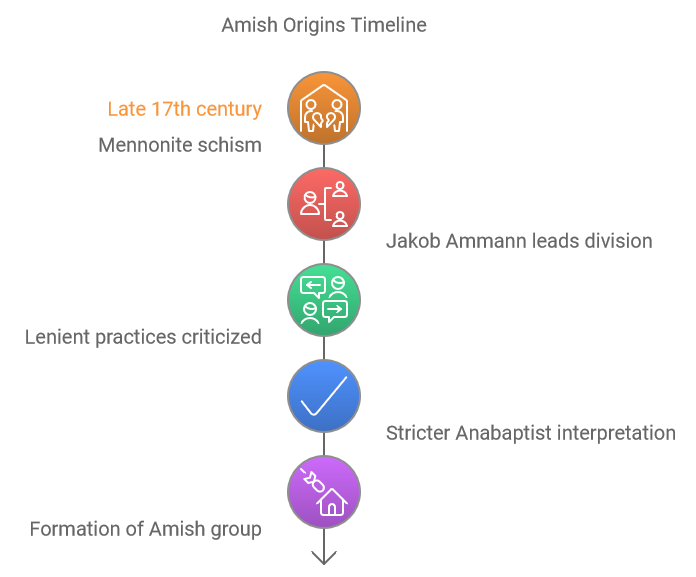The Anabaptist movement, which emerged in the early 16th century during the Protestant Reformation, is significant for its radical departure from traditional Christian practices, particularly in its advocacy for believer’s baptism. Unlike mainstream Christianity, which practiced infant baptism, Anabaptists insisted on the necessity of a personal, conscious decision to follow Christ before being baptized. This belief in adult baptism is one of their core tenets and underscores their commitment to individual faith and accountability【15†source】【16†source】.
Anabaptists also championed the separation of church and state, arguing that the church should govern itself without political interference. This stance was revolutionary at the time and led to significant persecution from both Protestant and Catholic authorities【17†source】. Their emphasis on living out the teachings of Jesus in community life and personal conduct has made them a distinct and influential group within Christianity, shaping conversations around religious liberty, pacifism, and community-oriented living【15†source】【17†source】.
Historical Context
The Anabaptist movement arose amidst the broader context of the Reformation in the 16th century, a time when many sought to reform the perceived corruptions of the Catholic Church. Reformers like Martin Luther and Ulrich Zwingli sparked widespread theological debates, leading to various splinter groups, including the Anabaptists. While some reformers sought to modify existing practices, Anabaptists believed that true reform necessitated a return to the New Testament model of faith, which included a complete rejection of infant baptism【16†source】【17†source】.
The Anabaptists’ insistence on adult baptism as a conscious commitment to faith set them apart. They viewed infant baptism as a remnant of a corrupt church and advocated for a “believer’s church” comprised solely of those who have made a personal decision to follow Christ. Additionally, their belief in the separation of church and state challenged the prevailing notion that the two should be intertwined, leading to severe persecution from both Protestant and Catholic authorities, who viewed these views as heretical【17†source】【15†source】.

Modern Anabaptist Groups
Today, the descendants of the Anabaptist movement are primarily known as Mennonites, Amish, and Hutterites. Each of these groups has maintained elements of the original Anabaptist beliefs while developing unique identities and practices over the centuries.
Mennonites
Mennonites derive their name from Menno Simons, a former Catholic priest who became a prominent leader in the Anabaptist movement. Under his guidance, the group adopted a more organized structure and distinct identity, emphasizing peace, community, and service【16†source】.
In contemporary society, Mennonites have modernized in many aspects, reducing their emphasis on traditional agrarian lifestyles and dress. They actively engage in various professions, contribute significantly to missions, and are involved in charitable work worldwide. Mennonite communities can be found globally, often participating in humanitarian efforts, reflecting their commitment to the values of peace and service rooted in their faith【15†source】【17†source】.

Amish
The Amish originated from a schism within the Mennonite community in the late 17th century. This division was led by Jakob Ammann, who believed that the Mennonites had become too lenient in their practices, particularly regarding church discipline and the practice of “shunning” those who violated community norms. Ammann and his followers advocated for a stricter, more literal interpretation of Anabaptist teachings, which eventually led to the formation of a distinct group—the Amish【15†source】【16†source】.
The Amish are well-known for their simple lifestyle, which is a direct reflection of their values. They prioritize humility, community, and separation from the materialism and distractions of modern society. This commitment to simplicity is most visibly expressed in their rejection of modern technology, such as electricity, automobiles, and telephones, which they believe could disrupt their close-knit community and lead to pride or competition【17†source】.
Living in tight-knit communities, the Amish focus on mutual aid and shared responsibilities. Their emphasis on humility and pacifism shapes their interactions with the outside world, as they avoid any form of violence or participation in government-related activities like military service. Their traditional farming methods and craftmanship not only sustain their way of life but also symbolize their commitment to preserving their values【15†source】【16†source】.
Hutterites
The Hutterites, another branch of the Anabaptist tradition, take communal living to an even more pronounced level than the Amish. They live in colonies where all property is owned collectively, and resources are shared equally among members. This form of communal ownership is based on the early Christian teachings found in the Book of Acts, where believers “had all things in common”【17†source】.
Hutterite life revolves around the collective, with each member contributing to the community’s agricultural and industrial operations. Their economy is based on farming, livestock, and various industrial activities such as manufacturing. By living and working together in these self-sufficient colonies, Hutterites emphasize simplicity, modesty, and separation from the broader society, much like their Amish cousins, though they tend to be more open to modern technology【15†source】【17†source】.
Core Anabaptist Principles
Despite the differences between Mennonites, Amish, and Hutterites, they share core beliefs that have their roots in the original Anabaptist teachings.
- Believer’s Baptism: All three groups reject infant baptism in favor of believer’s baptism, which they believe should be an individual, conscious decision made by an adult or a mature person who understands the faith【16†source】.
- Pacifism: Non-violence is a central tenet of all Anabaptist groups. They believe that Christians should not participate in war or violence in any form and are committed to resolving conflicts peacefully【15†source】.
- Living According to the Teachings of the New Testament: For Anabaptists, the teachings of Christ in the New Testament serve as the ultimate guide for personal conduct and community living. This includes the emphasis on humility, charity, and communal support, which all three groups uphold【17†source】.
Conclusion
Understanding the Amish, Mennonites, and Hutterites as modern descendants of the Anabaptist movement provides a window into how deeply held religious convictions shape lives and communities. Each group interprets their Anabaptist heritage in different ways, yet they all remain rooted in shared principles of adult baptism, pacifism, and simple, community-based living. Their unique ways of life continue to stand as a testament to their faith and resilience in the face of societal pressures to conform【15†source】.
Further Reading/References
- Encyclopedia.com – Detailed history of Anabaptist groups: Encyclopedia.com Anabaptist History
- Christianity.com – Overview of modern Mennonites, Amish, and Hutterites: Christianity.com Anabaptists【16†source】【17†source】.
FAQs about Anabaptists
1. What is the Anabaptist movement?
The Anabaptist movement emerged during the Protestant Reformation in the 16th century, advocating for adult baptism and the separation of church and state. Anabaptists emphasized a personal commitment to faith, rejecting infant baptism as incompatible with their beliefs【15†source】【16†source】.
2. Who are the main groups that descend from the Anabaptists today?
The primary modern descendants of the Anabaptist movement are the Mennonites, Amish, and Hutterites. Each group has its own unique beliefs and practices, but all share common Anabaptist roots【17†source】【16†source】.
3. What distinguishes the Amish from other Anabaptist groups?
The Amish, who separated from the Mennonites in the late 17th century under Jakob Ammann, are known for their strict adherence to traditional lifestyle practices. They resist modern technology and emphasize community living, humility, and pacifism【15†source】【16†source】.
4. How do Hutterites live differently than Amish and Mennonites?
Hutterites live communally in colonies, sharing all property and resources. They focus on collective ownership and self-sufficiency, operating agricultural and industrial businesses within their communities, which contrasts with the more individualistic approach of Mennonites and the family-based structure of the Amish【17†source】【16†source】.
5. What are the core beliefs shared by Anabaptist groups?
Anabaptist groups share several fundamental beliefs:
- Believer’s Baptism: Emphasizing that baptism should be a conscious decision made by an adult.
- Pacifism: A commitment to non-violence and peace.
- Living according to the New Testament: Adhering to the teachings of Jesus as a guide for personal conduct and community life【15†source】【17†source】.
6. Why is understanding Anabaptist communities important today?
Understanding Anabaptist communities offers insights into alternative ways of living that prioritize community, peace, and simplicity. Their practices challenge modern societal norms and contribute positively to discussions about faith, social justice, and sustainability【16†source】【17†source】.
